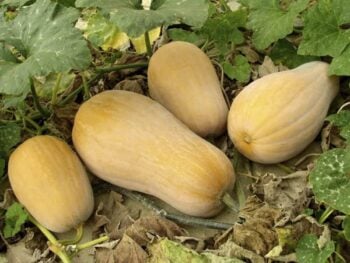Butternut squash is a winter squash with a sweet, nutty taste similar to that of a pumpkin. It has hard, yellow skin and orange fleshy pulp, and is an excellent source of nutrition during the winter months. This soup is one terrific way to enjoy it!
Winter Squash Nutrition
No single food provides a greater percentage of certain carotenoids (like alpha- and beta-carotene) in the diet than winter squash. The phytonutrients, complex carbohydrates and polysaccharides in winter squash are anti-inflammatory and help regulate blood sugar, too.
Butternut squash (and all winter squashes) also contain a great amount of vitamin C (about one-third of the Daily Value in every cup) and a very good amount of the antioxidant mineral manganese as well.
One cup of baked winter squash contains approximately 340 milligrams of omega-3 fats in the form of alpha-linolenic acid (ALA), and also provides a good amount of vitamins B1, B3, B6, pantothenic acid, and folate.
Related:
Selection and Storage of Winter Squash

Winter squash is easily prone to decay, so it is important to carefully inspect them before you buy them. Choose squashes that are firm, heavy for their size and have dull, not glossy, rinds. The rind should be hard all around. Avoid those with any signs of decay, which shows up as areas that are soft, water-soaked or moldy.
Depending upon the variety, winter squashes like butternut can be kept for one month to six months. The thicker the rind, the longer they tend to keep.
Keep winter squash away from direct exposure to light and do not subject them to extreme heat or extreme cold. The ideal temperature for storing winter squash is between 50-60°F (about 10-15°C).
Once it is cut, cover the pieces of winter squash in a glass storage container and store them in the refrigerator, where they will keep for a few days. The best way to freeze raw winter squash is to first peel it, then cut it into pieces of suitable size for your individual recipes.
All winter squashes need to be de-seeded before cooking. Save the seeds though; all winter squash seeds (not just pumpkin) are outstandingly nutritious, and can be dried, roasted and salted or seasoned with cayenne, cumin, ginger or other spices for a delicious snack!
You can also roast a winter squash and then peel the cooked, softened skin off or scoop out the flesh, which is often easier than peeling it raw. That is what we will do for this recipe.
This easy to make, roasted butternut squash soup recipe will nourish you well on cold winter days, and make the best of this healthy, long-storing vegetable.
Other Soups You’ll Love:
- Turkey Soup with Root Vegetables
- Authentic Tom Kha Gai (Thai Coconut Chicken Soup)
- The Easiest Crockpot Chicken Stock Ever
- Creamy Ham & Potato Soup (Dairy-Free with Paleo Option)

Easy Roasted Butternut Squash Soup
Equipment
Ingredients
- 1 medium butternut squash, halved and seeded
- 1/2 sweet onion, peeled and sliced
- 1 Tbsp. extra virgin olive oil
- 2 cups chicken broth, or stock (or use vegetable broth for vegetarian/vegan option)
- 1 tsp sea salt
Instructions
- Preheat oven to 350 degrees.
- Place the halved and seeded squash on an oiled roasting pan. Roast in the oven for an hour or until a knife goes in easily.
- Let the squash cool a bit, and remove the skin. Keep any parts of the squash flesh that have browned; it will add extra flavor.
- On medium heat, sauté the onion in the olive oil until translucent.
- Add the squash and the broth or stock to the pan and simmer together for about 10 minutes.
- Place the mixture and sea salt into your blender or Vitamix and secure the lid.
- Blend on low or 1 and slowly increase the speed to high or 10. Blend for 20 seconds, until smooth.








